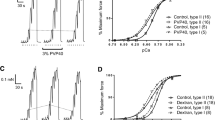Abstract
The purpose of the present study was to confirm the relationship between isolated frog muscle tension and muscle hardness by conducting physiological evaluation in vivo. Two different mounting forms of the muscle were adopted. One form placed the gastrocnemius muscle (GA) on a base plate; this dented the muscle as a “mass”. The other form tightened the sartorius muscle (SA) between holders in Ringer’s solution; this bent the muscle as a “string”. The first experimental method allowed testing of muscle hardness during stretching up to 140% (experiment 1) and the other method allowed testing of hardness during tetanic muscle contraction (experiment 2). The response force to vertical distortion, measured as muscle hardness, increased linearly with resting tension increase and this relationship was not influenced by the hysteresis (experiment 1). The response force increments at each level of tetanic muscle tension were proportional to the contracting tension (experiment 2). Although the muscle mounting forms were different, the response force increment to muscle tension in GA and SA showed quite similar relationships in both tests. It seems likely that muscle hardness evaluated by the response force must depend on the amplitude of the tension at the instant of the hardness measurement, regardless of the mounting form or the stretching phase (ascending or descending). In conclusion, muscle hardness measured by perpendicular distortion has physiological significance related to the changes in passive and active muscle tension.








Similar content being viewed by others
References
Ashina M, Bendtsen L, Jensen R, Sakai F, Olesen J (1998) Measurement of muscle hardness: a methodological study. Cephalalgia 18:106–111
Barry DT, Cole NM (1990) Muscle sounds are emitted at the resonant frequencies of skeletal muscle. IEEE Trans Biomed Eng 37:523–531
Bendtsen L, Jensen R, Jensen NK, Olesen J (1995) Pressure-controlled palpation: a new technique which increase the reliability of manual palpation. Cephalalgia 15:201–210
Cole NM, Barry DT (1994) Muscle sound frequencies of the frog are modulated by skeletal muscle tension. Biophys J 66:1104–1114
Fisher A (1987) Clinical use of tissue compliance meter for documentation of soft tissue pathology. Clin J Pain 3:23–30
Hatta I, Sugi H, Tamura Y (1988) Stiffness changes in frog skeletal muscle during contraction recorded using ultrasonic waves. J Physiol (Lond) 403:193–209
Higuchi H (1992) Changes in contractile properties with selective digestion of connectin (titin) in skinned fibers of frog skeletal muscle. J Biochem 111:291–295
Horikawa M (2001) Effect of visual display terminal height on the trapezius muscle hardness: quantitative evaluation by a newly developed muscle hardness meter. Appl Ergon 32:473–478
Horikawa M, Ebihara S, Sakai F, Akiyama M (1993) Non-invasive measurement method for hardness in muscular tissues. Med Biol Eng Comput 31:623–627
Horowits R, Kempner ES, Bisher ME, Podolsky RJ (1986) A physiological role for titin and nebulin in skeletal muscle. Nature 323:160–164
Jahnke MT, Proske U, Struppler A (1989) Measurements of muscle stiffness, the electromyogram and activity in single muscle spindles of human flexor muscles following conditioning by passive stretch or contraction. Brain Res 493:103–112
Jones DA, Newham DJ, Round J, Tolfree S (1986) Experimental human muscle damage: morphological changes in relation to other indices of damage. J Physiol (Lond) 375:435–448
Kato M, Murakami S, Matsumoto G (1979) On the stiffness of human tibialis anterior muscle during voluntary contraction (in Japanese). Front Med Biol Eng 17:258–263
Komiya H, Maeda J, Takemiya T (1996) A new functional measurement of muscle stiffness in humans. Adv Exerc Sports Physiol 2:31–38
Komiya H, Kurokawa N, Maeda J, Takemiya T (2001) Influencing factors on muscle stiffness accompanying stepwise increased muscle tension during isometric contraction of extensor digitorum muscle (in Japanese). J Exerc Sport Physiol 8:25–32
Maruyama K (1997) Connectin/titin, giant elastic protein of muscle. FASEB J 11:341–345
Murayama M, Nosaka K, Yoneda T, Minamitani K (2000) Changes in hardness of the human elbow flexor muscles after eccentric exercise. Eur J Appl Physiol 82:361–367
Nosaka K, Clarkson PM (1992) Relationship between post-exercise plasma CK elevation and muscle mass involved in the exercise. Int J Sports Med 13:471–475
Sakai F, Ebihara S, Akiyama M, Horikawa M (1995) Pericranial muscle hardness in tension-type headache. A non-invasive measurement method and its clinical application. Brain 118:523–531
Tamura Y, Hatta I, Matsuda T, Sugi H, Tsuchiya T (1982) Changes in muscle stiffness during contraction recorded using ultrasonic waves. Nature 299:631–633
Winters JM (1990) Hill-based muscle models: A systems engineering perspective. In: Winters JM, Woo SL-Y (eds) Multiple muscle systems: biomechanics and movement organization. Springer, Berlin Heidelberg New York, pp 69–93
Acknowledgements
This study was supported by a Grant-in-Aid for Scientific Research (No. 12780036) from Japan Society for the Promotion of Science.
Author information
Authors and Affiliations
Corresponding author
Rights and permissions
About this article
Cite this article
Murayama, M., Yoneda, T. & Kawai, S. Muscle tension dynamics of isolated frog muscle with application of perpendicular distortion. Eur J Appl Physiol 93, 489–495 (2005). https://doi.org/10.1007/s00421-004-1204-4
Accepted:
Published:
Issue Date:
DOI: https://doi.org/10.1007/s00421-004-1204-4




